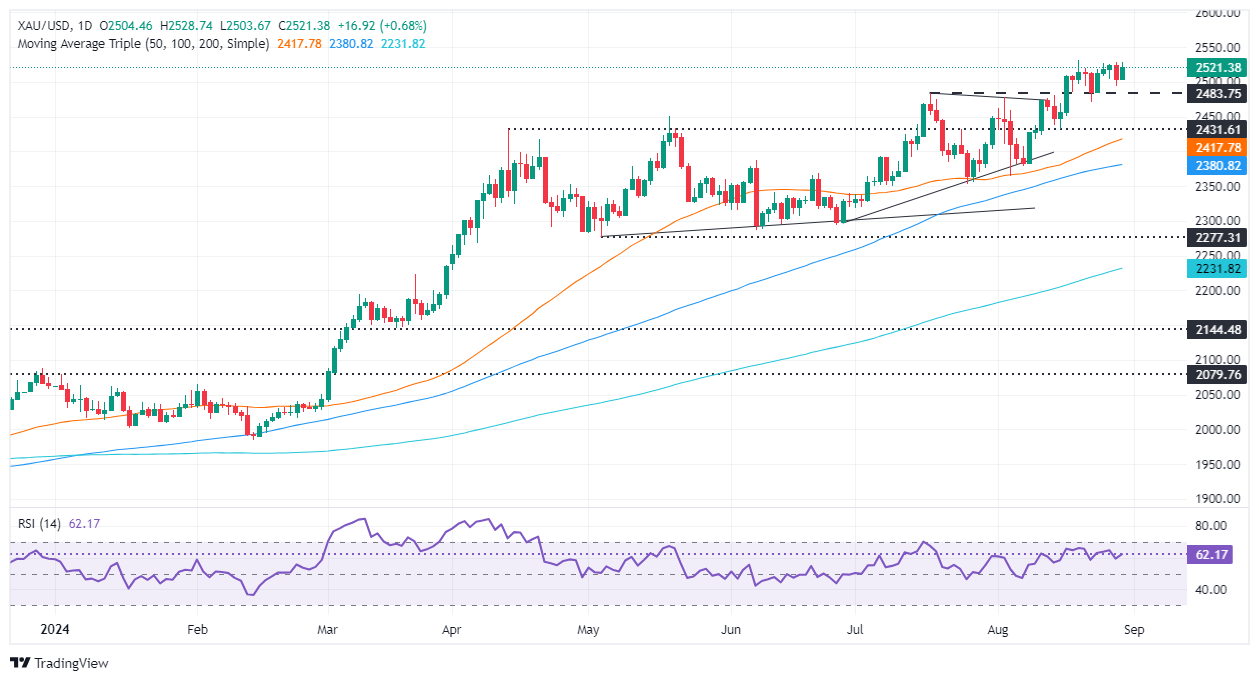- Gold prices climb despite upbeat US Q2 GDP revision and drop in unemployment claims.
- Despite rising US Treasury yields (10-year at 3.86%) and DXY up 0.33% to 101.38, Gold’s upward trend continues.
- Focus shifts to upcoming core PCE data, expected to slightly increase, potentially impacting Fed decisions.
- CME FedWatch Tool shows 65.5% likelihood of a 25 bps rate cut in September, bolstering Gold prices.
Gold prices rose late in the North American session even though the US economy remains resilient after Gross Domestic Product (GDP) figures propelled the Greenback higher. Despite this, Gold prices continue to grind higher amid expectations of the Fed’s first rate cut. The XAU/USD posted gains of 0.78% and exchanged hands at $2,523.
Market sentiment is positive, as traders remain laser-focused on data that could confirm the size of the Federal Reserve’s (Fed) first rate cut. In the meantime, the US Bureau of Economic Analysis revealed the country grew in Q2 2024 above the preliminary release, lifting the Personal Consumption Expenditures Price Index (PCE) Deflator with it.
At the same time, the US Department of Labor revealed that fewer than expected Americans applied for unemployment benefits, which is a relief for the Fed, which acknowledged in Powell’s speech that employment risks are tilted to the upside.
Despite that, the golden metal extended its gains above $2,520 even though the US 10-year Treasury note yield rose two basis points to 3.86%. Meanwhile, the US Dollar Index (DXY), which tracks the buck’s value against a basket of six currencies, climbed 0.33% to 101.38.
Given the backdrop, traders should expect that the non-yielding metal would aim lower, but investors see a 65.5% chance of a 25-basis-point (bps) rate cut at the September meeting, according to the CME FedWatch Tool, which underpins the precious metal.
On Friday, the Fed’s preferred inflation gauge, the core Personal Consumption Expenditures Price Index (PCE) is expected to tick a tenth higher, according to the consensus.
The December 2024 Chicago Board of Trade (CBOT) fed funds future rates contract hints that investors are eyeing 98 basis points of Fed easing this year, up from Monday’s 97.
Daily digest market movers: Gold price advances as traders brace for US Core PCE data
- If US economic data continues to be weak, the Gold price uptrend is likely to persist, fueling speculation about a larger rate cut by the Fed.
- The second estimate of US GDP for Q2 2024 showed a significant increase from 1.4% in Q1 to 3%, surpassing estimates of 2.8%. The Personal Consumption Price Expenditures (PCE) Deflator indicated that inflation dipped from 3.1% to 2.5% QoQ, slightly higher than the anticipated 2.3%.
- Initial Jobless Claims for the week ending August 24 decreased from 233K to 231K, slightly below the estimate of 232K.
- Next week, the US economic docket will feature the August Nonfarm Payrolls report, which could be crucial to assess the size of the Fed’s first rate cut at the September meeting.
Technical outlook: Gold price uptrend extends, traders eye $2,550
Gold price uptrend remains in place on Thursday. As price action pushes above $2,520, buyers remain hopeful that XAU/USD could climb past the all-time high (ATH) at 2,531. Momentum suggests buyers are in charge as the Relative Strength Index (RSI) portrays. Given that backdrop, Bullion’s path of least resistance is tilted to the upside.
If XAU/USD clears the ATH, the next resistance would be the $2,550 mark. A breach of the latter will expose $2,600.
Conversely, if XAU/USD slumps beneath $2,500, the first support would be the July 17 peak at $2,483. O; once cleared, the next support would be the $2,450 psychological mark, followed by the 50-day Simple Moving Average (SMA) at $2,414.
Fed FAQs
Monetary policy in the US is shaped by the Federal Reserve (Fed). The Fed has two mandates: to achieve price stability and foster full employment. Its primary tool to achieve these goals is by adjusting interest rates. When prices are rising too quickly and inflation is above the Fed’s 2% target, it raises interest rates, increasing borrowing costs throughout the economy. This results in a stronger US Dollar (USD) as it makes the US a more attractive place for international investors to park their money. When inflation falls below 2% or the Unemployment Rate is too high, the Fed may lower interest rates to encourage borrowing, which weighs on the Greenback.
The Federal Reserve (Fed) holds eight policy meetings a year, where the Federal Open Market Committee (FOMC) assesses economic conditions and makes monetary policy decisions. The FOMC is attended by twelve Fed officials – the seven members of the Board of Governors, the president of the Federal Reserve Bank of New York, and four of the remaining eleven regional Reserve Bank presidents, who serve one-year terms on a rotating basis.
In extreme situations, the Federal Reserve may resort to a policy named Quantitative Easing (QE). QE is the process by which the Fed substantially increases the flow of credit in a stuck financial system. It is a non-standard policy measure used during crises or when inflation is extremely low. It was the Fed’s weapon of choice during the Great Financial Crisis in 2008. It involves the Fed printing more Dollars and using them to buy high grade bonds from financial institutions. QE usually weakens the US Dollar.
Quantitative tightening (QT) is the reverse process of QE, whereby the Federal Reserve stops buying bonds from financial institutions and does not reinvest the principal from the bonds it holds maturing, to purchase new bonds. It is usually positive for the value of the US Dollar.

